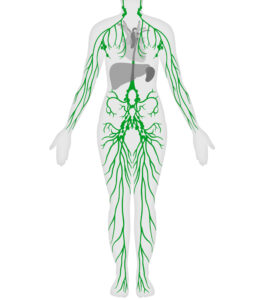 What is lymphoedema?
What is lymphoedema?
Lymphoedema is pronounced lim-fo-dee-ma. It is a long-term (chronic) swelling caused by a build-up of fluid in the body’s tissues. This happens when the lymphatic system, which normally drains fluid away, is unable to work properly. Lymphoedema can affect any part of the body.
The lymphatic system is part of the body’s immune system and carries a fluid called lymph. It is a one-way drainage system made up of channels (lymphatic vessels) starting underneath the skin and ending in the neck. This system works together with the blood system to transport the lymph fluid and remove waste products.
- The lymphatic system acts like a waste disposal unit to help drain away fluids and waste matter known as lymph from the body’s tissues.
- It is also part of the body’s immune system and helps to prevent infection.
The lymphatic system
The lymphatic system is part of the immunological system, primarily responsible for the transport of lymphatic fluid. Lymphatic fluid is a clear fluid, containing numerous different cells, including water, protein, lymphocytes, damaged cells and bacteria. This fluid is transported through vessels starting just under the skin in the superficial lymphatic system and from the organs in the deep system. The lymph system is closely related to the circulatory system. Lymph nodes are also an element of the lymphatic system, these nodes are responsible for filtering the lymph fluid, storing inorganic materials such as dust and dyes, they concentrate the volume of lymph and regulate blood volume.
Lymphoedema
Lymphoedema is swelling caused by a lack of drainage of lymph fluid, it may be either primary or secondary. Primary lymphoedema is caused by a genetic abnormality in the vessels or nodes, meaning that lymph is unable to be cleared from an area. Though the abnormality is present at birth, symptoms don’t always become apparent until puberty or even after the age of 35. Secondary lymphoedema arises as a result of trauma to the lymphatic system or overload of fluid in the tissues.
Secondary lymphoedema may arise from damage to the lymphatic system from cancer treatment either lymph node removal, radiotherapy or surgery or a combination of all three. Advanced cancer may also, in some situations, cause a blockage to lymph nodes or vessels. Lymphoedema can occur in any area of the body, meaning that the trunk or abdomen or even genitals can be affected.
It is important to recognise the early signs of lymphoedema. Early treatment for lymphoedema can help control swelling and prevent it getting worse. The early signs include:
- Swelling in part of your body. At first this may come and go and it will often be worse at the end of the day
- A feeling of heaviness, tightness, soreness or stiffness in the affected area
- Skin changes over time. For example, your skin may feel tight, shiny and taut
- Clothing or jewellery feeling tighter than usual
Early assessment and management of lymphoedema are key, if you have had treatment for cancer and you notice any changes with how your affected side feels you should book an assessment. At an assessment appointment the therapist will discuss your symptoms, when they started and the impact it may be having on daily life. They will take measurements of both limbs for comparison and discuss the tools that can be used daily to manage lymphoedema, including skin care and exercise. Treatment appointments will involve the therapist discussing how your symptoms are currently, any problems you may be encountering and then treatment using manual lymphatic drainage.
The management of lymphoedema consists of four corner stones:
Manual Lymph Drainage
This treatment consists of stimulation of the lymphatic system, applied through gentle but precise movements of the skin, in order to increase the amount of lymph fluid being drained from an area of congestion. This very gentle hands on therapy not only has an effect on the lymphatic system but also the body’s nervous system leaving it in a calm, relaxed state.
Skin Care – Skin care is essential in the management of lymphoedema to prevent infection and skin breakdown, daily application of moisturiser, careful nail care and avoiding treatments like waxing or wet shaving to the affected area are vital. The aim is to keep the skin of the affected area soft and supple.
Compression therapy – Compression therapy may be applied by compression bandaging (either by the therapist or the client can be taught to self bandage if needed) or by wearing specially fitted compression garments. Compression garments are available in a variety of styles, so there are lots of options to find the best fit both for a clients lifestyle and also their lymphoedema needs. Generally compression stockings are worn on the leg and compression sleeves on the arm. There are also compression wrap options available as stockings or sleeves may not be suited to every client.
Exercise – Gentle exercise is an essential aspect of managing lymphoedema, as the muscles in the limb can be used as a pump to help move lymph fluid from the affected area. Exercise in water is highly recommended as the pressure of the water itself also has a beneficial impact on the lymphatic system, eg aqua aerobics or aqua lymphatic therapy. Exercise such as Tai Chi, yoga and Pilates are also highly recommended. Clients who wear compression should wear their garment while exercising and ensure they are adequately hydrated.
The lymhoedema service at the Hope centre has 2 Dr. Vodder trained and MLD Ireland registered therapists, providing a service 3 days per week. Should you have any queries or concerns regarding lymphoedema please don’t hesitate to contact the centre.
This year we have received funding through the National Cancer Control Programme to support us in the delivery of our Manual Lymphatic Drainage (MLD) service. This is a very welcome development and we are delighted to receive the funds. The Hope Cancer Support Centre is also one of the chosen centres in the Country to be included in a new initiative looking at measuring the impact the provision of MLD services has on clients and their quality of living. This is the first time that this approach has been taken with the locally based Cancer Support Centres. We are looking forward to taking part in this study with the National Cancer Control Programme of the HSE.
